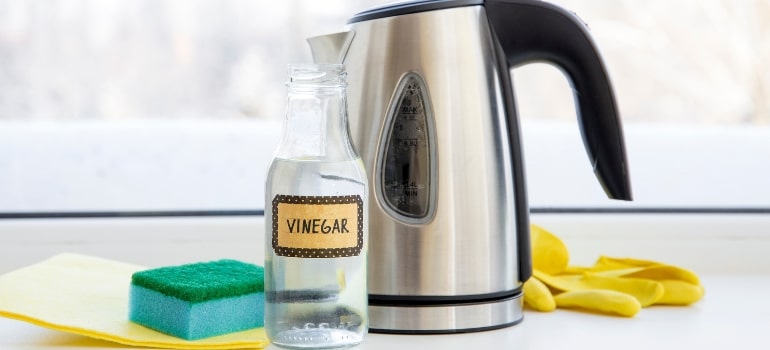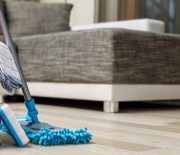Last update: 9 months ago

Despite its vital role in the culinary space, the humble kettle is often disregarded when it comes to regular maintenance and cleaning. Despite its renowned efficiency and safety in swiftly heating water, surpassing both the microwave and stove, it is unfortunately neglected.
Getting that morning coffee, a nice cup of tea or even soup has never been easier, though the privilege of enjoying all those things is endangered when the appliance is not properly sanitised. More importantly, our health could be at risk, so knowing how to clean and descale the kettle is essential.
Why you should clean your kettle?
Neglecting to clean the kettle for long periods of time could damage the appliance and the need for deep cleaning that may not prove successful after all. Limescale build-up is the biggest problem, which causes higher electricity consumption as the kettle takes longer to warm up the water. In addition, limescale affects the H2O quality, which tends to worsen the longer the kettle is not cared for.
Given that limescale is formed after hard water is boiled and left in a kettle, the best way to avoid the problem is not to leave the liquid to sit in the appliance. Also, using the kettle for cooking calls for more extensive cleaning. As for cleaning frequency, it mainly depends on the area you live in and the water quality there. Expert cleaners suggest you inspect your kettle weekly, and if you notice any hard white deposits, get to work right away.
Effective homemade methods for cleaning and descaling a kettle

Clean kettle with vinegar
Acid is a good hard water stain remover, which is why white vinegar is an important ingredient to include in your homemade descaler. This simple method could be used regularly to clean an electric kettle, whether it’s made of stainless steel, plastic, glass or other material.
The process consists of:
- Measuring two sufficient portions of white vinegar and water to cover the affected areas of the kettle, which are then poured into the appliance.
- Letting the solution boil and then leaving it inside for 15-20 minutes, after you unplug the appliance.
- Taking a toothbrush and starting to scrub the interior, but remember to focus on the edges and all those hard-to-reach places where limescale loves to hide.
- Rinsing the kettle at least 2-3 times before leaving it to dry.
- Boiling water to check the results of your work.
Cleaning a kettle using lemon and water
Cleaning a kettle with lemon and water solution is a natural and safe option compared to other harsh chemicals. The lemons will not just destroy the limescale but will also brighten up the kettle’s interior and provide a pleasant, refreshing smell.
- Cut and squeeze a lemon
Cut a lemon into two halves and squeeze the juice in the appliance. When you’re done, use the two halves and rub the inside parts to remove any hard water stains. Cut the lemon into small pieces and add the pieces to the lemon juice inside the kettle. - Create a mixture
Add approximately 500ml of water to the mixture. You don’t need to fill the kettle to the top, just make sure you pour enough to cover the bottom elements and to fill the appliance halfway. - Boil the lemon water
Turn on the kettle and let the solution boil. Let it sit for around 15 minutes. After that, disconnect the kettle from the power source. Leave the kettle for a couple of hours until it’s completely cooled off. - Scrub the kettle
Don’t throw out the lemon water yet. Use a soft sponge and scrub the inside and the outside of the kettle thoroughly. - Rinse and dry off the kettle
Remove the mixture and rinse the kettle 4-5 times with warm water. Use a microfiber cloth to dry off the outside of the kettle.
Cleaning a kettle with baking soda
Another natural cleaning option is to create a baking soda and water solution. Before proceeding with the cleaning, make sure the kettle is unplugged for your safety.
How to clean the outside of a kettle
To clean the outside of the kettle, create a solution with warm water and dish soap. Wash and scrub the outside of the kettle using a soft sponge. Rinse it with water and dry it off carefully using a microfiber cloth. Be careful not to get any soapy water inside the kettle. Make sure to clean the outside of the kettle at least once every two weeks or so.
Don’t put the appliance into a laver full of water. It can damage the heating elements irrevocably.
How to remove rust from a kettle
Kettles are constantly exposed to water, and if you live in an area with hard water and if there is moisture left in the kettle, it can rust. To prevent the rust from building up in your kettle, you simply need to wipe up the kettle after each use.
If there is rust on your cast iron kettle, you can remove it by scrubbing the rust stains gently with a wire brush. Rinse the residue with cold water. If there are still rust spots on the kettle, you can try soaking up the kettle in Coca-Cola. Pour enough cola to cover the bottom and leave it for 20 minutes. If there is a lot of rust left, you may need to leave it soaking overnight. Remove the cola and clean the kettle thoroughly with warm water.
Essential tips for cleaning a kettle
- To completely get rid of limescale, clean the kettle regularly by sprinkling baking soda and scrubbing the inside with a soft sponge.
- To remove limescale from the kettle’s filter, remove it and soak it in a cup of vinegar for 10 minutes to loosen up the stubborn residue. Use a soft sponge and scrub gently to clean it. Then rinse with water and let it dry.
- DON’T scrub the heating elements of the kettle because they have a special protective coat. If you scrub, you can remove it and damage the appliance when using it in the future.
- DON’T leave water in the kettle for too long, if you’re not planning to use it. It can damage the elements and even get rusty.
Takeaways
Leaving water in the kettle for a long time can harm its components and lead to rust formation. To prevent any harm, it is advised to empty out any leftover water after each use. But if keeping your household appliances clean and maintained is a challenge, think about hiring a professional cleaning service to assist you.
Do you need a helping hand?
Hire a professional cleaning team!





